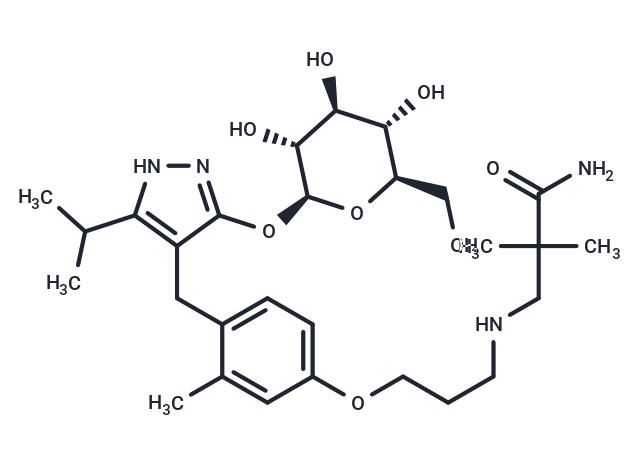Shopping Cart
- Remove All
 Your shopping cart is currently empty
Your shopping cart is currently empty

Mizagliflozin is an orally active, selective SGLT1 inhibitor with a Ki value of 27 nM for human SGLT1. Mizagliflozin is 303 times more selective for SGLT1 than for SGLT2. Mizagliflozin is an anti-diabetic drug that can improve postprandial blood sugar fluctuations and may have the potential to improve chronic constipation.

| Pack Size | Price | Availability | Quantity |
|---|---|---|---|
| 1 mg | $74 | In Stock | |
| 2 mg | $107 | In Stock | |
| 5 mg | $166 | In Stock | |
| 10 mg | $288 | In Stock | |
| 25 mg | $571 | In Stock | |
| 50 mg | $819 | In Stock | |
| 100 mg | $1,130 | In Stock | |
| 1 mL x 10 mM (in DMSO) | $223 | In Stock |
| Description | Mizagliflozin is an orally active, selective SGLT1 inhibitor with a Ki value of 27 nM for human SGLT1. Mizagliflozin is 303 times more selective for SGLT1 than for SGLT2. Mizagliflozin is an anti-diabetic drug that can improve postprandial blood sugar fluctuations and may have the potential to improve chronic constipation. |
| Targets&IC50 | SGLT2 (human):8170 nM(ki), SGLT1 (human):(ki)27 nM |
| In vivo | METHODS: Mizagliflozin (GSK-1614235 free base) (0.3 mg/kg, intravenous administration) and oral administration (3 mg/kg, oral administration) were administered to rats to study its pharmacokinetics and metabolite profile. RESULTS Mizagliflozin had different half-lives in rats (0.23 and 1.14 hours, respectively) depending on the administration route; the absolute bioavailability was only 0.02%; after oral administration, Mizagliflozin was mainly metabolized to its aglycone KP232 in the intestine. [2] |
| Alias | KGA-3235 free base, GSK-1614235 free base, DSP-3235 free base |
| Molecular Weight | 564.67 |
| Formula | C28H44N4O8 |
| Cas No. | 666843-10-3 |
| Smiles | CC(C)c1[nH]nc(O[C@@H]2O[C@H](CO)[C@@H](O)[C@H](O)[C@H]2O)c1Cc1ccc(OCCCNCC(C)(C)C(N)=O)cc1C |
| Relative Density. | 1.274 g/cm3 (Predicted) |
| Storage | Powder: -20°C for 3 years | In solvent: -80°C for 1 year | Shipping with blue ice. | |||||||||||||||||||||||||||||||||||
| Solubility Information | Methanol: 250 mg/mL (442.74 mM), Sonication is recommended. DMSO: 100 mg/mL (177.09 mM), Sonication is recommended. | |||||||||||||||||||||||||||||||||||
Solution Preparation Table | ||||||||||||||||||||||||||||||||||||
DMSO/Methanol
| ||||||||||||||||||||||||||||||||||||

Copyright © 2015-2025 TargetMol Chemicals Inc. All Rights Reserved.